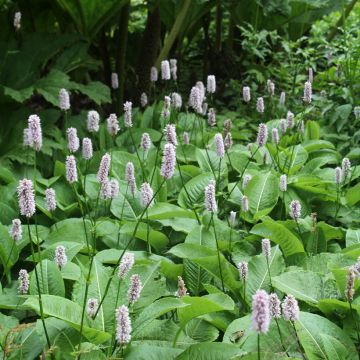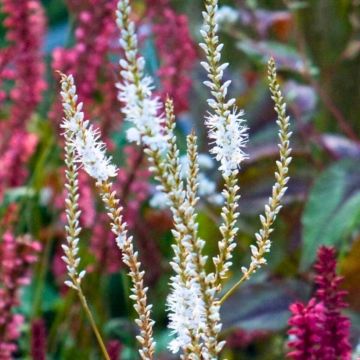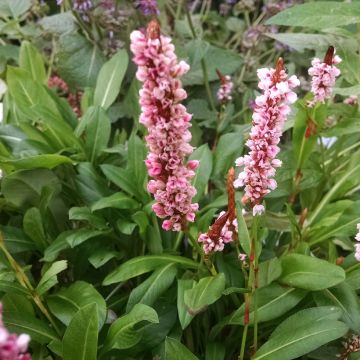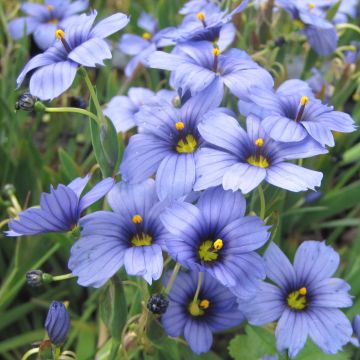

Renouée - Persicaire Indian Summer


Renouée - Persicaire Indian Summer
Persicaria Indian Summer - Knotweed
Persicaria Indian Summer
Knotweed, Smartweed
Beautiful young plant, which has managed to bloom, but has then suffered a bit from the Breton heatwaves, to be planted in shade or partial shade. It will survive nonetheless, no concerns to report! :)
Marie, 21/08/2022
Special offer!
Receive a €20 voucher for any order over €90 (excluding delivery costs, credit notes, and plastic-free options)!
1- Add your favorite plants to your cart.
2- Once you have reached €90, confirm your order (you can even choose the delivery date!).
3- As soon as your order is shipped, you will receive an email containing your voucher code, valid for 3 months (90 days).
Your voucher is unique and can only be used once, for any order with a minimum value of €20, excluding delivery costs.
Can be combined with other current offers, non-divisible and non-refundable.
Why not try an alternative variety in stock?
View all →This plant carries a 12 months recovery warranty
More information
We guarantee the quality of our plants for a full growing cycle, and will replace at our expense any plant that fails to recover under normal climatic and planting conditions.
Would this plant suit my garden?
Set up your Plantfit profile →
Description
The 'Indian Summer' Persicaria is a beautiful wild form of knotweed recently collected in India. It forms a lovely mass of leafy stems and establishes vigorously in moist soil, without becoming uncontrollable. Still relatively unknown in France, it stands out with its numerous clusters of exquisite ruby red flowers, and its beautiful round leaves that turn purple in the sun. This knotweed blooms continuously from July until the first frost. A fabulous ground cover that blends well in a naturalistic garden, reminiscent of tall grasses.
The Persicaria or Polygonum 'Indian Summer' is a plant in the Polygonaceae family. It is a botanical form discovered in the Mishmi hills (India) by Michael Wickenden, a passionate plant collector and curator of Cally Gardens in Scotland. This variety, still rarely found in French gardens, forms a clump 60 to 80 cm (24 to 32in) tall when in bloom and spreads quite rapidly, depending on the richness of the soil, to form imposing clumps after several years. The 'Indian Summer' Persicaria produces numerous clusters of shiny rose-red floral buds, revealing a tender pink heart when they open. Flowering is continuous from July-August until the frost, as long as the soil doesn't dry out too much. The leaves, carried by sturdy stems, are ovate and have a medium green colour when the plant is in shade. The stems and leaves take on a beautiful purplish hue when exposed to the sun.
Very versatile, this knotweed fits well in both contemporary gardens and wilder settings, and creates stunning autumn scenes with grasses such as Miscanthus and Panicum. Thanks to its spreading habit, it can be used as a ground cover, provided it is given enough space. This knotweed enjoys both sun and partial shade. It thrives in rich, heavy, moist, or even very wet soils, and can be grown independently on sunny pond banks, along a sunken path, or in a cool, semi-shaded woodland at the base of trees. Asters, Japanese anemones, and inulas are good companions for knotweeds, in the garden or in bouquets, as they also flower until autumn. Selinum wallichianum and Thalictrum delavayi 'Album' create an interesting contrast alongside it, against a backdrop of deciduous euonymus, Viburnum x hillieri 'Winton', splendid in autumn.
Persicaria Indian Summer - Knotweed in pictures




Flowering
Foliage
Plant habit
Botanical data
Persicaria
Indian Summer
Polygonaceae
Knotweed, Smartweed
India
Other Persicaria
View all →Planting and care
The Persicaria 'Indian Summer' thrives in a sunny or semi-shaded exposure. It is a very easy plant to grow, it even tolerates moderate periods of drought if the soil it receives is deep. Plant it in any type of soil, as long as it is fresh, clayey or humiferous, even marshy, in spring or autumn, in groups to create a mass effect. Enrich the soil with organic fertilizer at the start of the vegetation, as it is a voracious plant. Control its growth so that it does not harm neighboring plants. Mulch the soil in June in regions where the summer is hot and dry. Divide the clumps in October, every three years, and replant the plants in another part of the garden.
Planting period
Intended location
Care
Planting & care advice
-
, onOrder confirmed
Reply from on Promesse de fleurs
Similar products
Haven't found what you were looking for?
Hardiness is the lowest winter temperature a plant can endure without suffering serious damage or even dying. However, hardiness is affected by location (a sheltered area, such as a patio), protection (winter cover) and soil type (hardiness is improved by well-drained soil).

Photo Sharing Terms & Conditions
In order to encourage gardeners to interact and share their experiences, Promesse de fleurs offers various media enabling content to be uploaded onto its Site - in particular via the ‘Photo sharing’ module.
The User agrees to refrain from:
- Posting any content that is illegal, prejudicial, insulting, racist, inciteful to hatred, revisionist, contrary to public decency, that infringes on privacy or on the privacy rights of third parties, in particular the publicity rights of persons and goods, intellectual property rights, or the right to privacy.
- Submitting content on behalf of a third party;
- Impersonate the identity of a third party and/or publish any personal information about a third party;
In general, the User undertakes to refrain from any unethical behaviour.
All Content (in particular text, comments, files, images, photos, videos, creative works, etc.), which may be subject to property or intellectual property rights, image or other private rights, shall remain the property of the User, subject to the limited rights granted by the terms of the licence granted by Promesse de fleurs as stated below. Users are at liberty to publish or not to publish such Content on the Site, notably via the ‘Photo Sharing’ facility, and accept that this Content shall be made public and freely accessible, notably on the Internet.
Users further acknowledge, undertake to have ,and guarantee that they hold all necessary rights and permissions to publish such material on the Site, in particular with regard to the legislation in force pertaining to any privacy, property, intellectual property, image, or contractual rights, or rights of any other nature. By publishing such Content on the Site, Users acknowledge accepting full liability as publishers of the Content within the meaning of the law, and grant Promesse de fleurs, free of charge, an inclusive, worldwide licence for the said Content for the entire duration of its publication, including all reproduction, representation, up/downloading, displaying, performing, transmission, and storage rights.
Users also grant permission for their name to be linked to the Content and accept that this link may not always be made available.
By engaging in posting material, Users consent to their Content becoming automatically accessible on the Internet, in particular on other sites and/or blogs and/or web pages of the Promesse de fleurs site, including in particular social pages and the Promesse de fleurs catalogue.
Users may secure the removal of entrusted content free of charge by issuing a simple request via our contact form.
The flowering period indicated on our website applies to countries and regions located in USDA zone 8 (France, the United Kingdom, Ireland, the Netherlands, etc.)
It will vary according to where you live:
- In zones 9 to 10 (Italy, Spain, Greece, etc.), flowering will occur about 2 to 4 weeks earlier.
- In zones 6 to 7 (Germany, Poland, Slovenia, and lower mountainous regions), flowering will be delayed by 2 to 3 weeks.
- In zone 5 (Central Europe, Scandinavia), blooming will be delayed by 3 to 5 weeks.
In temperate climates, pruning of spring-flowering shrubs (forsythia, spireas, etc.) should be done just after flowering.
Pruning of summer-flowering shrubs (Indian Lilac, Perovskia, etc.) can be done in winter or spring.
In cold regions as well as with frost-sensitive plants, avoid pruning too early when severe frosts may still occur.
The planting period indicated on our website applies to countries and regions located in USDA zone 8 (France, United Kingdom, Ireland, Netherlands).
It will vary according to where you live:
- In Mediterranean zones (Marseille, Madrid, Milan, etc.), autumn and winter are the best planting periods.
- In continental zones (Strasbourg, Munich, Vienna, etc.), delay planting by 2 to 3 weeks in spring and bring it forward by 2 to 4 weeks in autumn.
- In mountainous regions (the Alps, Pyrenees, Carpathians, etc.), it is best to plant in late spring (May-June) or late summer (August-September).
The harvesting period indicated on our website applies to countries and regions in USDA zone 8 (France, England, Ireland, the Netherlands).
In colder areas (Scandinavia, Poland, Austria...) fruit and vegetable harvests are likely to be delayed by 3-4 weeks.
In warmer areas (Italy, Spain, Greece, etc.), harvesting will probably take place earlier, depending on weather conditions.
The sowing periods indicated on our website apply to countries and regions within USDA Zone 8 (France, UK, Ireland, Netherlands).
In colder areas (Scandinavia, Poland, Austria...), delay any outdoor sowing by 3-4 weeks, or sow under glass.
In warmer climes (Italy, Spain, Greece, etc.), bring outdoor sowing forward by a few weeks.






























































